We’ve all fallen victim to the distractions and disruptions brought about by unwanted external noise. Whether it be the honking of cars outside your office window, a screeching train passing by your house at all hours of the day, or the roar of planes flying overhead, many find themselves combating sleepless nights and unfinished work simply from unwanted noise alone. As a result, home and business owners often find themselves shopping for soundproofing solutions for their spaces. However, it can be an overwhelming process to compare all the materials and products available on the market today. Most importantly, just how can you be sure the product you purchase will actually be effective in soundproofing your home or office?
While you may be familiar with Sound Transmission Class (STC) ratings, there is another relatively new way of measuring sound transmission: Outdoor-Indoor Transmission Class (OITC). Similar to STC ratings, OITC ratings provide information on how well a barrier blocks sound, and should be taken into consideration as you shop for soundproofing options.
What is Outdoor-Indoor Transmission Class (OITC)?
OITC is a measurement that indicates the rate of transmission of sound between an outdoor and indoor space. This form of measurement was created to best determine the level of performance of products in eliminating exterior noise, which can often permeate barriers through heavy, low frequencies. Additionally, OITC ratings are used to determine how capable products are for use in low frequency sensitive areas. The OITC rating scale captures transmission loss results between 80 and 4,000Hz.
Frequency, Decibels, Transmission Loss
To understand OITC, it is first important to have a grasp on the units involved in its measurement. The most important terms to understand are frequency, decibels, and transmission loss.
Frequency: The frequency of a sound is the measurement of its musical note. Simply put, frequencies, which are measured in hertz (Hz) unit, capture the number of sound waves that pass by per second. The human ear is capable of hearing frequencies that span the range of 20Hz to 20,000 Hz. Interestingly, the range humans can hear is most broad while we’re young, and continues to shrink as we get older and our hearing declines.
Decibels (dB): While frequency measures the tone of a sound, decibels are the unit of measurement that shows just how loud a noise is. The Sound Pressure Scale begins at 0 dB, which marks the threshold of audibility for humans. The average home maintains a decibel level somewhere between 40-50 dB, a comfortable and safe level for humans. However, once a noise passes 130 dB, hearers will experience physical pain, discomfort, and even injury.
Transmission Loss: When it comes to OITC ratings, transmission loss is key. This easy measurement simply takes the difference in volume, measured in decibels, between either side of a wall. If you stand in the room while your son plays the drum, the noise he creates may register at 100 dB. Leave the room and close the door, and only 75 dB may register. The difference between the two measurements sits at 25 dB. This difference in volume represents the transmission loss, effectively capturing the amount of sound absorbed by a given barrier.
How is OITC Measured?
Just as STC ratings are measured, OITC is determined based on the sound intensity lost through a barrier and captured in decibels. For example, a passing commuter train may register at 105 dB to a person standing outside on the platform waiting to board. On the other hand, someone in a nearby office building may only register 80 dB due to the barrier of their door or windows. The 25 dB difference represents the transmission loss as a result of the amount of sound absorbed by the door or window. The success with which a barrier achieves a specific decibel deficit is dependent on the frequency of the sound permeating through, with particularly low and high frequencies being the most difficult to block. OITC ratings are calculated over the frequency range of 80 to 4000 Hz, and are weighted more towards low frequencies. Once a barrier is tested against the range of frequencies and the results are plotted on a graph, the curve created is compared against OITC standards determined by the American Society for Testing and Materials (ASTM). This then provides a product’s OITC rating.
OITC vs. STC: Understanding the Difference
With all this mention of OITC and STC, you may be wondering how the two forms of measurement actually differ. Historically, professionals in the soundproofing business have relied on the STC rating system. STC is often used to assess a number of different types of barriers, including windows, doors, partitions, and exterior and interior walls. A newer form of measurement developed in 1990, OITC was created primarily to measure the ability of street sounds to travel through exterior walls, facade elements, and windows. Exterior sounds that OITC was developed to capture include those such as construction noises, car horns, and even airplanes. Because outside noises like those mentioned tend to emit at lower frequencies, the OITC rating system places an emphasis on low frequency noises in the way ratings are calculated.
In general, the STC rating system is still the preferred rating method when comparing a product’s soundproofing abilities. However, if low frequency sounds like a neighbor’s bass-heavy music or planes flying overhead cause the most disruptions in your home or office, you should consider the OITC rating for any interior or exterior barrier.
OITC and Soundproof Windows
When shopping for soundproof windows, there are a couple of factors to take into account when considering which rating, STC vs. OITC, to rely on. In general, OITC may be most appropriate if low frequency noises are an issue, like airplanes and heavy traffic. Though still a new method of measurement, OITC is becoming a more widely applied determiner of effectiveness in a window’s ability to block out external noise. For the average home that sees a range of sounds across high and low frequencies, STC ratings are preferable and trusted by professionals in the soundproofing industry.
For years, CitiQuiet has been the top trusted provider for soundproof windows in New York and other metropolis cities around the US. Our windows are top-grade and eliminate 95% of unwanted noise, as well as reduce dirt and drafts. We take into OITC sound rating systems to ensure top-of-the-line performance in our soundproof technology. Contact us for more information on how we can bring peace and serenity to your home with soundproof windows.



